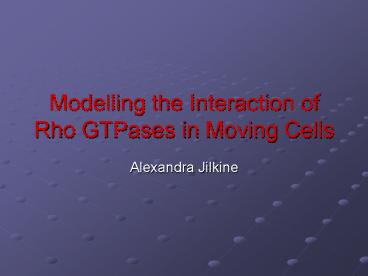Modelling the Interaction of Rho GTPases in Moving Cells PowerPoint PPT Presentation
1 / 15
Title: Modelling the Interaction of Rho GTPases in Moving Cells
1
Modelling the Interaction of Rho GTPases in
Moving Cells
- Alexandra Jilkine
2
How Cells Move
From Molecular Biology of the Cell, Alberts et
al. (2002)
3
Rho Family GTPases
- Key players in cell motility
- Link receptor signaling to assembly of the
cytoskeleton - Molecular switches cycle between inactive
(GDP-bound) and active (GTP-bound) forms - Transduce upstream signal to downstream effectors
in their active state
4
Some members of the Rho family
- Rac activates formation of lamellipodia and is
necessary for cellular protrusion. - Cdc42 activates formation of filopodia and
regulates polarization. - Rho is necessary for contraction of the cell body.
5
Cdc42, Rac and Rho in migrating cells
- High concentration of active Rac is found at the
front of the migrating cell concentration
decreases towards rear of the cell - The Rho concentration is the inverse of Rac
highest at the rear and decreasing towards the
front - Cdc42 tends to have same distribution as Rac
Rac, Cdc42
Rho
Rac, Cdc42
Rho
BACK
FRONT
6
Interactions of the Rho GTPases
- Multiple (often contradictory) interaction
schemes have been proposed
7
Model Formulation
- Idealize pathways as direct effects (positive or
negative feedback) - Assume a vast pool of inactive forms and only
keep track of the active forms - Determine which interaction schemes give rise to
a local (ODE) model that has bistability - High CDC42/Rac, low Rho
- Low CDC42/Rac, high Rho
- Add diffusion of proteins to get a reaction
diffusion system
8
Questions to Address
- Which proposed interaction schemes are not
consistent with biological observations? - What features are necessary to achieve bistable
behavior? - What kind of reaction kinetics predict the
distribution of Cdc42, Rac, and Rho found in
migrating cells? - What distinguishes these different kinetics
biologically?
9
Possible Interaction Schemes
- From the 5 pathways listed, only pathway 2)
- has feedback to Cdc42 from the other proteins
- In other cases the level of Cdc42 would be
independent of Rac and Rho levels, so feedback to
Cdc42 is necessary. - Mutual inhibition between Cdc42 and Rho is
necessary to achieve a high Cdc42/Rac, low Rho
and low Cdc42/Rac high Rho system
10
What are the corresponding kinetics?
- One protein can exert a positive effect on
another via two different processes - Increase conversion of GDP-bound to GTP-bound
(active) form - Decrease conversion of GTP-bound to GDP-bound
form - We look at the consequences of these different
assumptions
11
Different Inhibitory Kinetics
- 1) Increasing the GTP-hydrolysis rate will not
work. - 2) Slowing down GDP/GTP exchange can give us
desired behavior.
12
Activation Inhibition Model
This is the minimal model that is plausible with
the biology
13
Spatial Variant
Want to develop spatial segregation in response
to signal
14
Polarization due to Amplification of a Gradient
15
Polarization due to Injection of Active Protein

